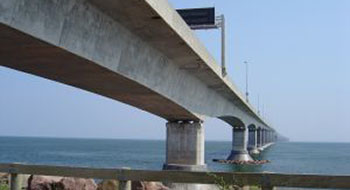
The pension industry will be watching to see if the Liberal government makes good on its promise to invest in Canada’s infrastructure when it unveils its first budget on Tuesday.
The Liberal government has been in talks with Canada’s largest pension funds about investing in infrastructure projects to help stimulate the economy, according to a Reuters article published in February.
Canada’s top pension funds have said they want to invest in these projects but they have conditions.
Read: Canada opens talks with pension funds on infrastructure investment
Read: Scrapping pension funds’ investment limit could enhance infrastructure
Climate change makes it all the more urgent for Canada to upgrade its deteriorating infrastructure, particularly by focusing on rapid transit and social housing, experts argue.
The number of natural hazards is increasing due to climate change, while man-made threats such as terrorist attacks are also on the rise, Saeed Mirza, an emeritus professor in McGill University’s department of civil engineering, said via email.
“This will make the present deteriorated condition of [Canada’s infrastructure] considerably worse. . . . Consequently, there is an immediate and urgent need for significant investment in existing deteriorated infrastructure to salvage it and to conserve it for future generations.”
The price tag for these upgrades is hefty. Mirza estimates that Canada needs about $500 billion to upgrade its civil infrastructure. On top of that, the country’s energy infrastructure needs an investment of about $300 billion in electrical power generation and transmission infrastructure — plus another $200 billion for oil and gas extraction as well as pipelines.
The Liberal government has said it’s willing to run three consecutive annual budget deficits of up to $10 billion to help fund infrastructure investments.
Pension funds want in
Canada’s biggest defined benefit pension funds have expressed interest in contributing capital to these projects. “We’d like to participate. We’re significant players,” Michael Latimer, president and CEO of the Ontario Municipal Employees Retirement System (OMERS), said at a recent panel discussion in Toronto about the Liberal government’s infrastructure plans. OMERS declined to comment for this story.
Read: OMERS buys into Spanish pipeline operator
Canada’s top pension funds have significant infrastructure investments around the world. Pension funds like these assets because their steady, long-term returns are a good match for pension liabilities.
But as more capital chases these infrastructure assets, particularly core assets — those that don’t require improvement and therefore don’t carry excessive risk — they’ve become more scarce and expensive worldwide.
“The core space is more crowded. The core deals are seeing more competition,” said Todd Nelson, investment practice leader in Willis Towers Watson’s Toronto office. “It’s harder to find those deals with reasonable returns. So it may take core investors longer to get their core portfolio to work.”
The federal government’s infrastructure projects could potentially offer pension funds good investment opportunities in both the greenfield and brownfield spaces.
High speed rail and social housing needed
While no details have emerged yet about specific projects, Mirza said one thing Canada definitely needs is the introduction of rapid transit, particularly high-speed rail. This should take priority over building or upgrading highways, he added. “Improved and fast transit systems and high-speed rail would be more effective than travelling by car and would also help reduce atmospheric pollution.”
Read: Teachers’ increases stake in airport
Social housing across Canada is another area that needs attention, according to Mirza. “The current situation of the homeless and poor citizens is quite unacceptable,” he said. “The indigenous people are living in awful conditions, needing very urgent improvement in their drinking water and sewage infrastructure; of course, they need to be better connected to [the] rest of Canada.”
Apart from construction and upgrades, the government and other investors will also need to consider maintenance and the cost that comes with that, Mirza added. “A paradigm shift is needed from the current practice of ‘design, build and forget’ to ‘design, build and maintain over the entire service life.’”
While Canada’s top pension funds are interested in providing some of the capital to achieve all that, they have conditions.
One is scale: the projects need to be large, said Mark Wiseman, CEO of the Canada Pension Plan Investment Board (CPPIB), speaking together with OMERS’ Latimer at the same panel, which was hosted by the Canadian Club. The CPPIB declined to comment for this story.
Read: New government brings infrastructure investment opportunities
Read: Liberals want pension funds to invest in infrastructure
Another condition is an independent and stable regulatory framework, Ron Mock, president and CEO of the Ontario Teachers’ Pension Plan, said at the same event. “You can’t put $2 billion to $3 billion into a country only to find that every four years the rules are changing on you — the tax rules, the way you construct, how you operate.”
The pension funds would also need to remain independent in these projects and invest on commercial terms, Mock added. “There is no pension obligation to help out [with Canada’s infrastructure needs]. We have to invest globally on commercial terms.”
Additionally, Mock said, Canada’s federal, provincial and municipal governments need to be better aligned. “If you’re in an infrastructure project where all three levels are fighting with one another, it’s a big problem.”
Australia is a country where those three levels of government are in alignment, which is why it’s an attractive place to invest in, Mock explained. “In Canada, I think there’s work to be done. . . . But I will say the government has heard us collectively about this issue.”
Read: Canada’s pension funds pulling back on global infrastructure
